Introduction
Economic dynamics and urban processes, such as urban sprawl, urban shrinkage and deindustrialization, transform the landscape of cities, giving rise to a significant number of vacant and derelict land plots. In some cases, this land is in a temporary state, with a high likelihood for economic redevelopment (Pagano and Bowman 2000). However, when population growth is unlikely to occur and vacant land has little to no real market value, these plots become “urban voids” constituting “negative spaces” within the urban fabric (Kim, Miller, and Nowak 2018). In order to avoid this having an adverse impact on the surrounding community, vacant land should be redeveloped or reused to provide long-term or interim services to urban dwellers. Yet, in a number of occasions, traditional (state or market driven) approaches have failed to bring them to life, due to lack of necessary funds, investment interest or/and deficiencies in property rights. It has been argued by scholars of different perspectives that the management of these spaces by a community of local residents as a commons, constitutes a successful and sustainable practice, capable of addressing the social, political, environmental and nutritional needs that contemporary cities encounter, especially in times of crisis (Anthopoulou et al. 2017; Paschalis A. Arvanitidis and Nasioka 2017; McMichael 2000).
However, the issue of defining this community remains controversial among commons scholars. Should the boundaries around the community be strict or fuzzy, and how important is group specification for the success of commons endeavors? On these grounds, some scholars (Ostrom 1990, 90; Agrawal 2001, 1654; Butler 2013, 92) highlight the need for communities to be clearly and explicitly defined in order for collective action to be successful. In such cases, participants’ actions are easily observable (Meinzen-Dick, DiGregorio, and McCarthy 2004, 5) and this informal monitoring provides a degree of certainty, consistency and continuity to the dynamics of the initiative which helps eventually build trust and increases the social capital (Butler 2013, 92–93). In projects where participation conditions are loose and open (either because it is difficult or undesirable to exclude potential participants), individual commitment might be low and free riding can take place, resulting in frustration and eventually in the abandonment of the project (Paschalis A. Arvanitidis and Papagiannitsis 2020; Feinberg et al. 2021). Yet there are many successful examples in which the boundaries of the community are informal, fuzzy, and unclear (Meinzen-Dick, DiGregorio, and McCarthy 2004, 5–6), reflecting the anti-authoritarian and anti-capitalist ethos that permeates these initiatives.
The current paper aims to contribute to this discussion. In particular, it seeks to explore the role that political ideology plays in prescribing community boundaries and the effect this usually unspoken rule has in the sustainable management of the resources. In doing so, the paper employs the social–ecological systems (SES) framework (Ostrom 2009, 419–22; McGinnis and Ostrom 2014) to analyze two urban community gardening initiatives located in Athens, Greece, that differ by looseness of membership conditions and their subjectability to political conviction.
The paper is structured as follows: the following section discusses the “tragedy” of the common pool resources (CPR) and the need for collective action, focusing on Ostrom’s perspective. The second section outlines the research methodology. Section three uses an empirical method to analyze two urban community gardens commons initiatives.
Theoretical background
Vacant urban plots are typical examples of common pool resources (CPR), characterized by non-excludability, meaning that it is too difficult (i.e. too costly) to exclude people from using them, and rivalry, meaning that their use by some reduces their availability to others (Paschalis A. Arvanitidis and Nasioka 2017). These features force rational individuals to exploit the resource, thus ignoring the social, long-term costs of their actions, which eventually lead to degradation and even complete destruction of the CPR. To avoid this “tragedy” (Hardin 1968), collective action is required (Ostrom 2006, 151).
Two approaches, identified in literature, have been proposed as solutions, constituting the First and Second Generation Theories of Collective Action. The first of these is Hardin’s, who, using the typical example of an open-access pasture, concludes that overexploitation is unavoidable unless credible property rights are attributed, either to individuals (privatization) or to the state (nationalization) (Basurto and Ostrom 2009, 256), giving the owner incentives and the authority to enforce resource sustainability.
However, the conclusions of the first generation theory have been challenged by Ostrom’s perspective on collective action. Drawing on a number of empirical studies across the world (Ostrom 1990), she demonstrated that communities can successfully manage CPR by themselves, even in the absence of private property rights (privatization) or a strong regulatory authority (nationalization) (Poteete and Ostrom 2008, 178; P. Arvanitidis and Nasioka 2018). As a result, a third, more socially acceptable governance regime emerges, the commons, where the users come together to form suitable rules and mechanisms for the sustainable management and appropriation of their CPR (Ostrom 2011b, 50).
Ostrom has put considerable effort into trying to identify a number of characteristics that are common to such successful regimes (1990). Eight design principles have been proposed, which aim to characterize robust commons and help communities create, develop and sustain these institutions. These, according to Ostrom (1990, 90) and explicated by Cox et al. (2010), are:
- Clearly Defined Boundaries:
- User boundaries: Individuals or households with rights to withdraw resource units from the CPR are clearly defined.
- Resource boundaries: the boundaries of the CPR are clearly defined.
- Congruence:
- Appropriation and provision: the distribution of benefits from appropriation rules is roughly proportionate to the costs imposed by provision rules.
- Congruence with local conditions: appropriation rules restricting time, place, technology, and/or quantity of resource units are related to local conditions.
Collective-Choice Arrangements: Most individuals affected by the operational rules of the resource should be able to participate in the modifying of operational rules.
Monitoring: Monitors actively assess the condition of the CPR and the appropriators’ behavior and are accountable to the appropriators and/or are the appropriators themselves.
Graduated Sanctions: Appropriators who violate operational rules will receive sanctions which gradually increase in severity.
Conflict-Resolution Mechanisms: Appropriators and their officials are required to have good access to low-cost conflict resolution mechanisms to resolve conflicts among appropriators or between appropriators and officials.
Minimal Recognition of Rights to Organize: The appropriators have formal approval and the right to devise their own institutions which is not challenged by external governmental authorities.
Nested Enterprises: Appropriation, provision, monitoring, enforcement, conflict resolution and governance activities are organized in multiple layers of nested enterprises.
Upon realizing the need for a common communication language for the study of the commons, Ostrom and her colleagues developed two methodological tools to support this analysis (2011a, 23): the Institutional Analysis and Development framework (2008, 819–48), and the Socio-ecological systems framework (2009, 419–22), which is used in the current research.
Research methodology
In order to explore our field of research we analyze two urban community gardens located in the Attica region in Greece, but with quite different urban commons regimes: the Agroscholoi Vrilissou and the Botanical garden of Petroupoli. Aiming to identify similarities, differences and patterns across the two cases, the social-ecological systems (SES) methodological framework was used. The SES framework was developed to support communication across the multiple disciplines concerned with sustainable provision and/or appropriation of common-pool resources (CPRs). It consists of eight groups of first-tier variables outlining: the Resource Units (RU), the Resource Systems (RS), the Governance Systems (GS), the Actors (A), and the resulting Interactions (I) and Outcomes (O), in the context of Related Ecosystems (ECO) and the Social, Economic, and Political Settings (S) (McGinnis and Ostrom 2014).
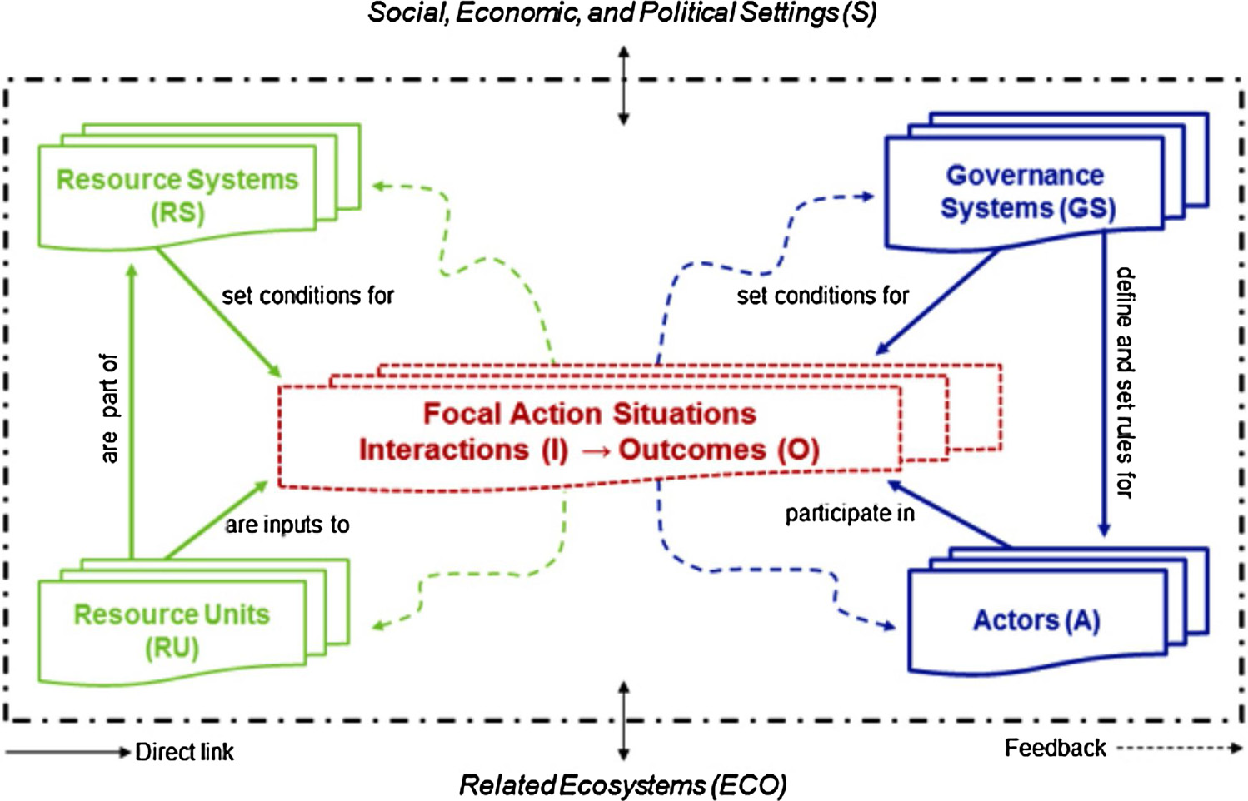
An urban community garden, thus, is seen as a socio-ecological system comprised of a resource (the garden) that provides resource units (garden products and added social value) to users (volunteers) who join forces to collectively run the garden by articulating a governance system (institutions for the management of the garden) (Feinberg et al. 2021).
Much of the work undertaken on community gardens has applied the SES framework of analysis on the basis that these systems are quite complex and so there are multiple variables affecting their function and outcomes (Butler 2013, 6).
In our SES specification, we began by reviewing the modified list of second-tier variables suggested by McGinnis and Ostrom (2014) to replace or exclude second-tier variables irrelevant to our case. We also incorporated new third and fourth-tier variables. This process of replacement/exclusion and development of new variables resulted in the SES framework presented in the next section.
Concerning case selection of the study, both our cases involve food growing and are located in Attica to ensure contextual comparability. The data collection and analysis methods are based on a combination of secondary and primary data aiming to increase the validity and reliability of the research. Data collection techniques include interviews based on semi-structured questionnaires and participant observations (taking place in 2016 and 2017).
Empirical study
Agroscoloi Vrilissou
The idea of creating an urban farm first aired in the meetings of the Nature Club of Vrilissos in the summer of 2011. The community started with a core of 20 people, all members of the Nature Club of Vrilissos, and began to expand rapidly, soon doubling in size. The group soon became more “formalized” with six members set to comprise the management committee. In addition, a self-run fund for members’ contributions was created (in order to cover the current expenses of the cultivation activities). The members of the committee alternate at regular intervals in a circular order, and are all members of the community and the Club.
Following the success of a “pilot” urban farming attempt in a private plot, in 2011, the Club decided to ask the Municipal Council of Vrilissia for a piece of land in the former Naval Base–the 52,000m2 Maria Callas park–to create an urban farm and a training center for climbing (see Fig. 2). Following a positive recommendation, the Council ceded a 200m2 plot to the Agroscholoi Vrilissou group.

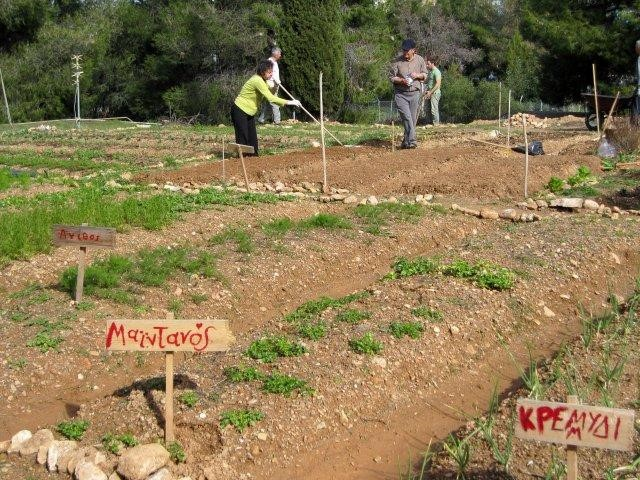

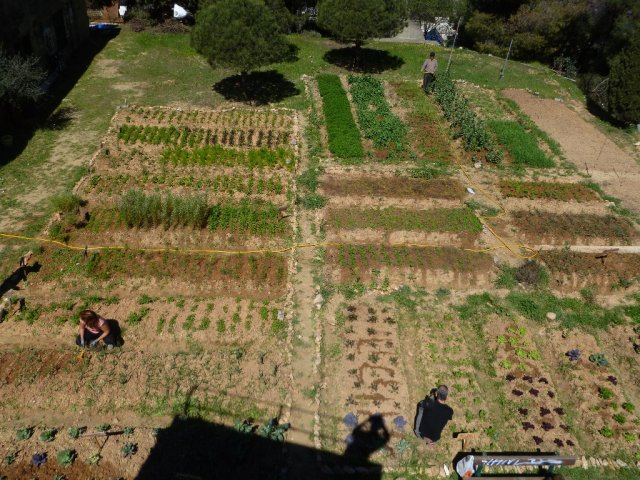
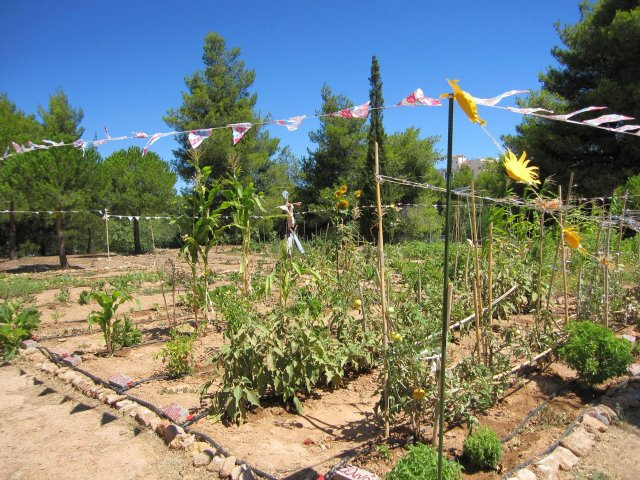
The country’s deep economic recession (S1.1) played an important role in the creation of the Agroscholoi Vrillisou group. In turn, the political developments of the time (S1.2) were much less influential.
As regards the Resource System (RS) variables, the sector which that community garden belongs to is urban commons (RS1). The boundaries of the resource are clearly defined (RS2.1) and the garden is partially fenced. In addition, there are boundaries to extraction access and property (RS2.2) since only group members can appropriate the garden. The size of the resource is medium (200m2 plot) and remained relatively constant throughout the years of appropriation by the group (RS3).
Turning to the Actors (i.e. urban community garden participants), the group is small and stable in size, the number of the members involved in the initiative is about 15 people (A1), rather homogenous (A2.1) in terms of their socio-economic characteristics. The resource can only be used by qualified Club members (A2.2.2), and in order to become one there is a requirement of paying the membership annual fee on the Nature Club of Vrilissos. Therefore, there is a direct link and dependence on the Nature Club of Vrilissos. Regarding history and past experiences, the initiative is still active (A3.1) and grows a variety of fruit and vegetables with the food being shared amongst its members. There are past collaborative experiences among the members of the group (A3.2), as the participants are all members of the Nature Club.
Although the members are against having formal leaders (A5.1), when asked whether or not anyone within the group can be seen as a leading figure the answer was that one individual takes on much of the responsibility and possesses a lot of the knowledge, thus they can be seen as an informal leader (A5.2). From the norms of appropriation, it is also clear that there is a kind of leadership, since few individuals decide what would be harvested and they also control all financial decisions. In short, the group is against the idea of leadership but there are informal leaders nonetheless.
Yet, a strong sense of community with a shared obligation is also apparent within the group. In particular, norms of trust and reciprocity imbue the community indicating a high level of social capital (A6.1). In particular, it is evidenced that all the activities related with the appropriation of the garden are shared, and members put in equal amounts of time and effort (but it is not an issue if sometimes they don’t). Participants also described a culture mutual help within the garden project. In addittion, trust levels are very high within the group, which is something that ensures cultivation continuation.
In the case of Agroscoloi Vrilissou, members of the group seem to share knowledge (A7) amongst themselves regarding the aim of the project. Due to their participation in the Nature Club, which is common to all the members, they know each other to a considerable extent and have a common set of principles regarding nature.
The importance of the resource is high and there is a direct financial dependence on it (Α8.1). The members also run a programme of educational events, while the initiative is also used to express members’ ecological attitude (A8.2).
Concerning the regime type and the determination and enforcement of property rights from the landowners, the Municipal Council of Vrilissia clearly acknowledges the groups’ right to organize (GS4). The Council supports the initiative, providing water supply and electricity to the scheme. In addition, Council members declare their presence at the events organized by the group, which is indicative of the Municipal Council’s support.
Regarding the presence of operational rules, despite the fact that the rules of the group are not written down, informal rules of appropriation or norms are present (GS5). Appropriation rules of the group refer mainly to the harvesting process and consumption of the resource (practical harvesting rules). The garden is organic only and, therefore, there presumably are rules–at least in the normative sense–about what substances can be used on the resource. There are restrictions on the quantity of the resource unit that can be extracted, there are rules regarding technology allowed to be used–the use of heavy agriculture machines is forbidden, the use of pesticides is not permitted either, as the cultivation is organic, and any unsustainable practice/behavior towards the environment is prohibited.
Formal structures for collective decision-making are not present in case of Agroscholoi Vrilissou (GS6). The members of the group have some autonomy in the decision-making, but the Nature Club holds a certain amount of power as they are making decisions in the interest of the garden (direct dependence on the Nature Club). There is no general assembly for decision-making, it is simply coordinated in the presence of all members. For certain issues (such as requests to the Municipality) the group is not allowed to act arbitrarily and the Nature Club must mediate to process them.
There are no constitutional choice rules (GS7); however, the decision-makers (at the level of constitutional selection) are the group of Agroscholoi Vrilissou, but directly dependant on the Nature Club and the Municipality.
Although there are normative rules surrounding inappropriate harvesting practices, graduated sanctions and monitoring procedures do not appear to be present (GS8). This can be related to the fact that there are no real appropriation rules or monitoring in place.
All the above variables have a major impact on particular patterns of interactions and outcomes. In particular, the resource is partially fenced (RS2.1) and so rather accessible, enabling free riding to take place (I1.1), but not to a great extent. There have been cases of harvesting crops by outsiders, as well as petty theft.
Concerning deliberation processes, the group held informal meetings (not regular) in which members are able to propose changes and have discussions over cultivation processes on site (I3). The group usually meets every Saturday in the plot, but also once a month at the offices of the Nature Club. These meetings provide an opportunity to discuss issues concerning the group, to analyze cultivation issues, to propose solutions and useful tips, as well as to make suggestions for future actions. All of the participants stated that they felt informed regarding what was going on with management issues of the resource. In order to keep members informed, general coordination is usually done through messages, phone calls (the small number of the group (A1) allows that) or e-mails and Google Groups conversations. There is also a Facebook page and a website of the Nature Club.
The group is committed to harmonious coexistence and cooperation and no particular conflicts amongst its members have been observed (I4). This is attributed to both the small number of users (A1) and their shared identity (A2).
Investment activities in the plot (I5) is a clear indication of the group’s commitment to the initiative. Several investment activities have been carried out, such as planting of fruit trees, construction of compost, etc.
Agroscholoi Vrilissou are connected to a great number of other groups and collectivities (Ι8.3), clubs (Ι8.1), while the local authorities have supported the initiative since it’s inception (I8.2).
The absence of graduated sanctions or clear appropriation rules (GS8) can be related to a lack of monitoring activities (I9). Minimum monitoring activities take place only during members’ visits to the resource for cultivation activities. Partial fencing of the space does not completely prevent (small-scale) infringements, similar to those which have been happening in the past.
Next, social and ecological performance measures describe the results of the interactions among the aforementioned variables. Regarding the social performance measures (Ο1), in the case study of Agroscholoi Vrilissou, the cultivation takes place collectively and the products produced are also equally distributed (Ο1.1.1). The only exception is when sensitive products are being harvested and someone is not present to get his share. The group also has an equal work distribution (O1.1.2), e.g. the watering days are shared and two people come each time for watering. The only exception–with the workload not being equal in terms of time and effort–being members voluntarily taking on greater responsibilities. The level of collective action of the group is characterized as durable and sustainable (O1.2). Concerning financial and material resources to operate the resource system, the initiative seems to be economically efficient (Ο1.3). In order to be financially secure, the group obtains the necessary funding to sustain itself by selling some of the produced products (such as wine, aromatic plants, etc.). In addition, there is a monthly fee of €2 per person.
A number of actions of the group have also impacts on ecological performance. In particular, conservation and sharing of phytogenetic resources contribute to the management of the global CPR problem of biodiversity conservation (Ο2.1). In addition, organic garden waste collected by the group members is turning into compost, improving soil quality and garden vitality, as well as reducing waste that burdens the environment when ending up in landfills (O2.2). Finally, it is worth noting that the resource continues to flourish (O2.3) demonstrating its sustainability and durability.
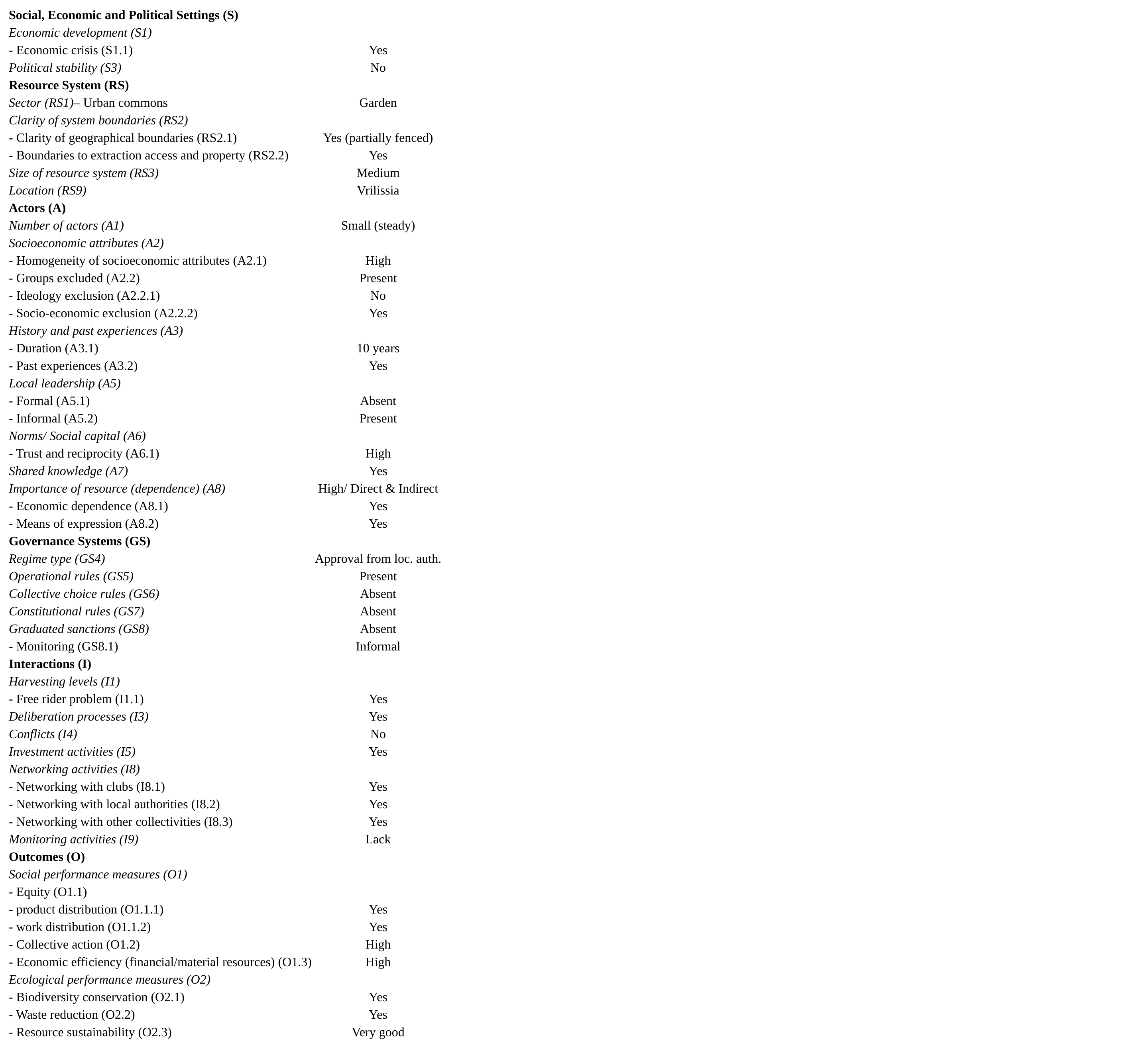
Botanical garden of Petroupoli
The botanical garden of Petroupoli is a state project initiated by the Ministry for the Environment, Physical Planning and Public Works of Greece in 2000, aiming to provide a place with controlled environmental conditions in order to plant rare tropical plants. However, due to high maintenance costs the project was eventually abandoned and the constructed greenhouse building was used by the Municipality of Petroupoli as a cultural center. In the summer of 2009, the Municipality finally gave it up and eventually the building was vandalized, looted and fell into disrepair.

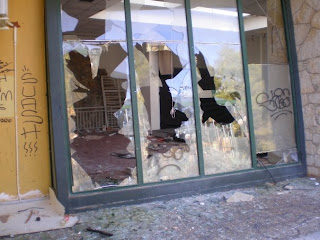
At the end of October 2009, a group of anti-authoritarian civil activists occupied the place and put it into use as a political-cultural center for the neighborhood. The initiative was soon supported by the local inhabitants of Petroupoli, who actively participated by organizing various cultural, artistic and other social activities. Eventually, the building was used by a number of other groups operating in the space, including a theatrical workshop, a children’s workshop, a reading group, a yoga group, a film group, as well as a cultivation group that made use of the botanical garden space. The purpose of the botanical garden group was to create an urban community garden cultivating food with biological/traditional agricultural practices and operating a community seed bank (repository of traditional Greek seeds) in order to distribute part of the products to citizens during events.
It should be noted that cultivation activities in the botanical garden of Petroupoli lasted 7 years and at the end of the summer of 2016 the project was ended. The analysis that follows draws on the last meeting with the group, held few months before its dissolution. However, other activities continue to take place in the greenhouse building (which is called a “social center” by the participants).
The occupation of the botanical garden of Petroupoli was part of the general climate of creating new forms of resistance, promoting self-organization and social solidarity, that was triggered after the December 2008 riots in Greece. The roots of the initiative, therefore, have a clear political/ideological dimension (S3).
The community garden (greenhouse) belongs to the urban commons sector (RS1). The boundaries of the resource are clearly defined (RS2.1), as the greenhouse has a glass surrounding and there is a lockable gate at the entrance. There are no boundaries to access and appropriation (RS2.2) since no membership is required for participation. The ideological standpoint of the group is that the community should be open for anyone willing to join the initiative. The fact that anyone can join at any point has an effect of creating some inconsistency within the group and makes difficult to get people committed in terms of the day-to-day running of the garden. The size of the resource is small (RS3) and remained relatively constant throughout the years, since it is a greenhouse (static).
Regarding the variables of the actors, there was a very low (steadily decreasing year after year) number of people involved in the initiative before the dissolution of the group, then consisting of only two members (A1). The group appears to be homogenous in terms of socioeconomic attributes (A2.1). There are no groups prohibited from receiving the benefits of the collective good due to their social and economic status (A2.2.2), however, adherence to a specific political ideology possibly sets boundaries to the community (A2.2.1), since people with right-wing or liberal ideology seem to be excluded from the commons. The initiative managed to survive for 7 years (from 2009 to 2016) (A3.1) and then ceased operations as community participation declined. Concerning leadership, the collectivity (including both the gardening group and other groups of the movement) is strongly against having any form of leadership (formal or informal leaders) due to their commitment to a non-hierarchical way of living (A5).
During the time of the research, it was evident there was a strong sense of trust and reciprocity within the group (A6.1). However, the group was far too small, so this variable is not taken into significant consideration in the analysis. Shared knowledge (A7) amongst the members is not taken into consideration in the analysis either due to the small number of participants.
The importance of the resource was medium (A8), as the dependence on it was mainly indirect (no direct financial dependence - A8.1), and the governance of the resource was treated as a means of political (anti-capitalist, anti-authoritarian, etc.) expression (A8.2). Moreover, the ideological attitude of the members was also expressed through other activities that were held in the place, making the dependence on the resource even weaker.
In terms of the determination and enforcement of property rights from the land owners, the Municipality never took legal action to claim the land (informally ceding the right to organize to the group) indicating their “tolerance” towards the initiative (GS4). The collectivity believes that clear appropriation rules were not required (informed by the ideological standpoint of the group), however, appropriation norms as regards harvesting process were present.
Formal structures for collective decision-making were not observed (GS6) and the members had a high degree of autonomy in terms of undertaking actions. This happened due to the fact that the cultivation group did not convene a separate assembly to make decisions, but took to part in the central assembly of all groups, making decisions on all issues and activities relative to the space.
There were no constitutional choice rules (GS7) and the decision-makers (at the level of constitutional selection) are the members of the whole initiative. Graduated sanctions and monitoring procedures did not appear to be present (GS8). However, due to the type of the resource, no free riding problems had been reported.
In the case of the community garden, the free rider problem was present to an extent (Ι1.1), but not as a violation (i.e. appropriation of resource units without the permission of the group). More specifically, volunteers were not motivated to participate in the cultivation activities, as the group provided free of charge seedlings to citizens (for the dissemination of traditional genetic material). In other words, anyone could receive the benefits produced by the community regardless of their participation in the cultivation processes.
Regarding deliberation processes, the cultivation group of the garden held weekly meetings for the collective as a whole (I3) (participation of all groups together–general open assembly) aimed at solving problems and discuss the progress of the initiative. Information on the activities of the initiative was available on their blog, which was updated on a regular basis.
There was no mention of conflict amongst members (I4), but this may be due to the small number of participants.
Investment activities that took place include an automatic irrigation system installation, a compost system construction, a fence placement and the replacement of broken glass windows of the greenhouse building (I5).
The members of the botanical garden of Petroupoli are connected to a great number of other groups and collectivities (Ι8.2). Regarding networking with local authorities or the State (I8.1), the initiative was not sought to have state or local council support. There were no control and sanctioning rules (GS8) due to the ideological position of the members. Also, no monitoring activities took place since the gated space prevents delinquent actions (I9.1).
During the group activation, for the reasons mentioned above, there was no equality in the distribution of both work (people volunteering) (O1.1.2) and products (free of charge seedlings were provided to anyone interested) (O1.1.1). The economic efficiency of the group is a difficult issue to assess, as all the groups rely on their own financial and material resources. All groups together undertake events and the resulting financial resources are collectively shared (O1.3).
The ecological performance indicators of the garden were quite high, since it contributed significantly to the conservation and dissemination of phytogenetic material (biodeversity) (O2.1). A clear sign of the ecological contribution of the group is that, in a single event (on 04/21/2010) about 1,000 seedlings were distributed to be cultivated by the citizens who responded to the group’s call. The group also cared about reducing waste (O2.2); to do so, organic garden waste was collected by the group members to be turned into compost, improving the quality of soil and the garden vitality. Finally, regarding the sustainability of the resource, during the activity of the group, it was maintained in a very good condition (O2.3), especially if compared to its previous situation.

Comparative evaluation
Table 3, below, summarizes the preceding rich discussion aiming to provide a basis for comparative evaluation of the aforementioned cases. For this reason, the framework used is the Ostromian design principles.
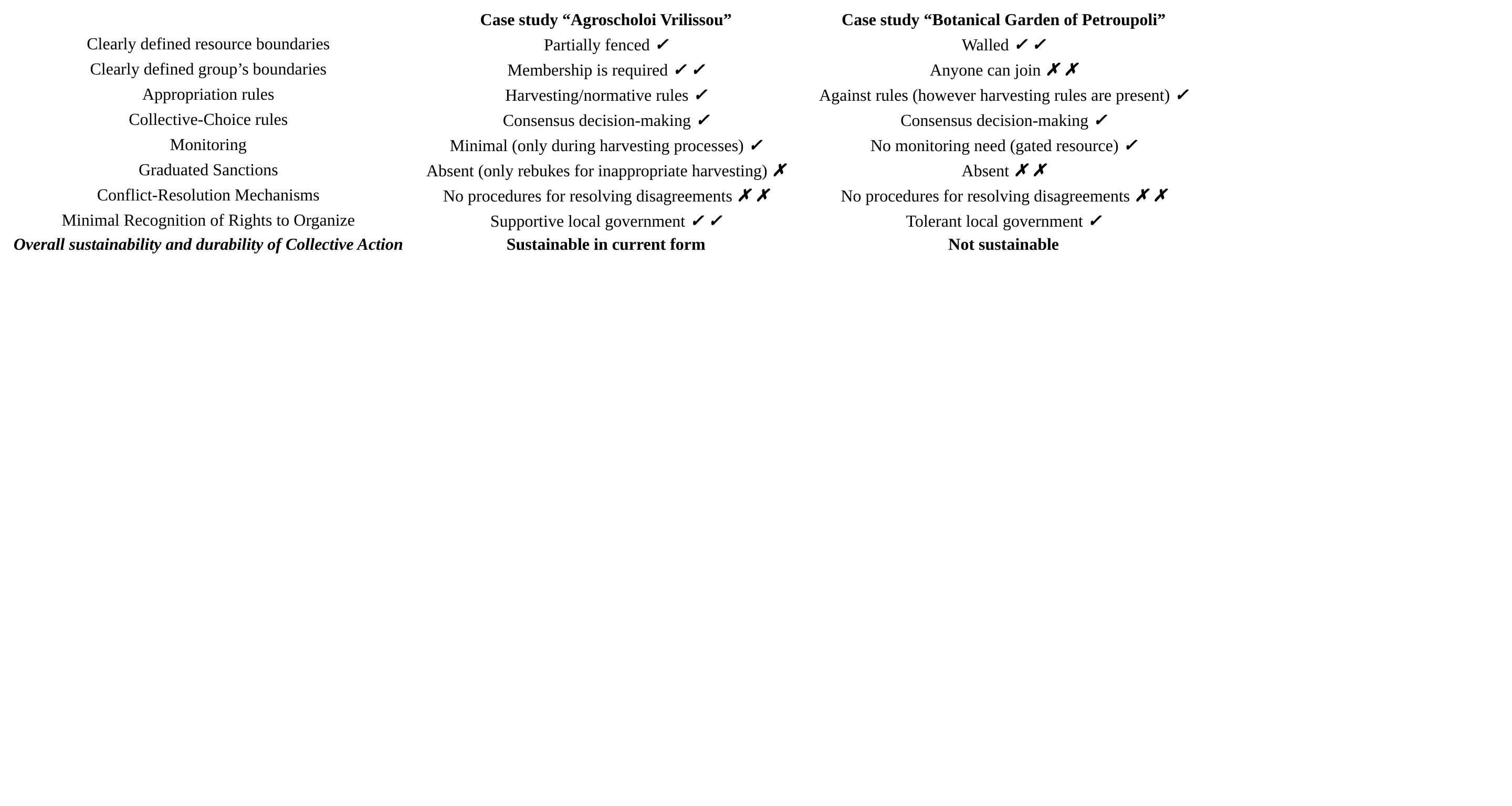
From the results of each case study, it becomes apparent that no case study is the same in terms of the variables that are present and their influence on the outcome of collective action varies greatly from case to case. Although Ostrom (1990) states that all design principles are required for collective action to be achieved, this does not appear to be evident in this research. Concerning the first case study, even though not all the design principles are present, collective action is still taking place and the quality of the resource has been maintained. On the other hand, the botanical garden of Petroupoli was not proved to be a successful case in terms of collective action and this is mainly due to its “openness”, which is in opposition to Ostrom’s principle of well-defined group boundary.
Conclusion
Regarding the first case study, Agroscholoi Vrilissou constitutes a successful example of collective action and is likely to continue into the future, since the conditions for durability and sustainability seem to be present. To start with, participation is consistent and regular. The boundaries of the group are clearly defined and there is stability of the people that manage the resource. A strong sense of community is present and variables such as trust, reciprocity and common understanding appear to be vital elements that influence cooperation within the community. Another highly significant variable of this case is the local government’s support towards the initiative. Not only it approves the community’s “right to organize”, but it also provides it with material means to run the project (water and electricity supply). Although monitoring is essentially absent and sanctions are minimal, the resource is continuing to flourish, showing that not all principles presented in the literature have to be enforced to maintain the quality of the resource.
The second case study, the botanical garden of Petroupoli, constitutes an ended project. Although the initiative presented a remarkable lifespan, many of Ostrom’s principles were not evident and this had an impact on the durability of the collective action. In particular, the boundary of the group was not well defined and, although the project aimed for complete openness, people of certain ideological background were not eligible to participate. Participation in the initiative faced a year-after-year decrease due to the ideological “charging” of the resource, which may have been a deterrent to individuals of different ideological backgrounds to join the project. Moreover, low dependence on the resource led to its gradual abandonment.
Summarizing the above, in line with previous research, we have found it is not necessary to fulfill all Ostromian design principles for successful collective action. For the kind of resources we examined (i.e. urban community gardens), key variables which appear to be critical to the success of the project seem to be the direct (nutritional, economic) dependence on the resource, the existence of clear appropriation rules (even if informal), the presence of leadership and clear boundaries to the group. On the other hand, from the prevailing evidence, it seems that the ideological “charging” of the resource, i.e. participation to the commons and the governance of the resource to be treated as a means of ideological (anti-capitalist, anti-authoritarian, etc.) expression, is being associated with less sustainable examples. It seems that, although adherence to a specific political ideology possibly increases community coherence, it also jeopardizes commitment to credible management of the CPR. This is due to their insistence against hierarchical forms (leaderhip), rule enforcement and users’ exclusion (open communities). Especially concerning the latter, open communities are connected with acts of free riding resulting on low commitment of the members and decreased participation.
Homogeneity of the group (i.e. the extent to which participants have similar socioeconomic backgrounds and social values) and social capital between members seem to be necessary but not sufficient conditions for successful collective action. It must also be noted that these variables (trust, reciprocity, homogeneity and common knowledge) remained somewhat unclear and are not taken into significant consideration in our analysis, due to insufficient data during the fully operational period of the initiative of the botanical garden of Petroupoli. Thus, further research is needed for clear results about these variables to be drawn.
As reality is extremely complex, the ability of these structures to evolve under changes occurring in the broader environment is exceptionally important. Changes in multitude of variables, as well as in the broader social, economic and political environment, may influence the collective action outcome at any time.
